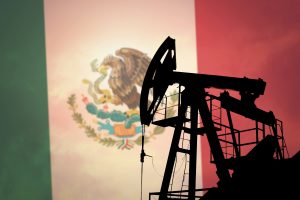Oil & Gas Sector in Mexico: Comisión Nacional de Hidrocarburos Announces Petróleos Mexicanos Invitation to Bid for Ayín-Batsil Farmout
/NewsFrom JDSUPRA.com / by Shearman &Sterling LLP, co-author: Ana María Alpízar
 “On September 18, 2017, the Mexican government, through the Comisión Nacional de Hidrocarburos (National Hydrocarbons Commission or “CNH”), commenced an international tender process to grant the right to enter into a license agreement in partnership with the productive state-owned enterprise PEMEX Exploración y Producción, to pursue upstream activities in deep waters in the Nobilis-Maximino.”
“On September 18, 2017, the Mexican government, through the Comisión Nacional de Hidrocarburos (National Hydrocarbons Commission or “CNH”), commenced an international tender process to grant the right to enter into a license agreement in partnership with the productive state-owned enterprise PEMEX Exploración y Producción, to pursue upstream activities in deep waters in the Nobilis-Maximino.”
“The areas up for bid, AE-0077-M-Cinturón Plegado Perdido-03, AE-0082-2M-Cinturón Plegado Perdido-8 and AE-0110-Cinturón Plegado Perdido-09 (Nobilis-Maximino), are former assignation contracts migrated into exploration and extraction agreements as part of the PEMEX business plan 2017-2021 and pursuant to the recent Energy Reform.”
“The international tender process identified as CNH-A5-Nobilis-Maximino/2017 is directed to domestic and foreign private companies and comprises the auctioning of a 1,509.421 sq. km area located on the coast of the state of Tamaulipas in the exclusive economic zone of the Gulf of Mexico.”
“The pre-qualification documents are required to be filed by the interested parties between November 6 and 10, 2017 and pre-qualified bidders will be announced on December 20, 2017. The bids will be due and opened on June 19, 2017, and the award will take place on January 31, 2018. A detailed calendar of the process is available through this link (Click here); the process contemplates three rounds of questions and answers.”
“The complete set of the bidding guidelines and pre-qualification criteria are available through this link (Click here).”
“The terms of the license agreement to be awarded and joint operating agreement to be executed in connection therewith are available through this link (Click here).”
From JDSUPRA.com / by Shearman &Sterling LLP, co-author: Ana María Alpízar
Forex – Mexico Flows: MXN back to 17.75. Recovering from earthquake impact
/NewsFrom fxmarketalerts.com / 11:17 (GMT) 20 Sep
“MXN is back to 17.75 after sell off in the aftermath of early afternoon earthquake that caused loss of life and building collapses in the capital and southern cities. The economic impact for the economy does not seem to be large to impact the currency which is back to watch FOMC statement for direction. The FOMC is expected to announce the start of the balance sheet reduction and the tone of the statement will determine how much the back end of the curve corrects. It will be interesting how the Mexican curve back end responds how large could be MXN adjustment. So far the market feels that the balance sheet correction has already being priced in and MXN could even rebound if the FOMC comes neutral to market expectations.”
“Today, we have no relevant data in the domestic market and in the US, as mentioned, the highlight is clearly Wednesday’s FOMC decision, which includes an updated SEP and press conference. We expect no change in rates with the focus on commencing balance sheet reduction. The Fed has already outlined fairly detailed plans and we are unlikely to see any major shocks, that doubtless the committee’s intention. On the economy the tone should not change much, optimistic while noting short term risks from recent hurricanes. August CPI should allow them to continue to expect inflation to move up to target in the medium term, despite the data having disappointed in the months before the latest release. Data wise, we see August existing home sales unchanged at 5.44m.”
From fxmarketalerts.com / 11:17 (GMT) 20 Sep
Mexico’s CENAGAS to auction 2.3 Bcf/d of capacity on US cross-border pipelines
/NewsFrom Platts / Calgary / 7 Sep 2017 503 pm EDT/2103 GMT
“Mexico’s National Gas Control Center will auction 2.3 Bcf/d of capacity across five US cross-border pipelines on behalf of state electricity utility CFE on September 10.”
“The capacity of the pipelines will be auctioned under a one-year contract starting October 1 and running until September 30, 2018.”
“CFE is offering 1.22 Bcf/d on the Trans-Pecos Pipeline (from Waha to Presidio) at an exit tariff of 13 cents/MMBtu; 700 MMcf/d on the Comanche Pipeline (Waha-San Elizario) at 18.58 cents/MMBtu; 293 MMcf/d on the Road Runner Pipeline at 47.25 cents/MMBtu; 39.4 MMcf/d on the NET Mexico Pipeline with an exit tariff of 37 cents/MMBtu; 19.7 MMcf/d on the El Paso Natural Gas Pipeline (lateral Wilcox) at 19 cents/MMBtu and an additional 16.3 MMcf/d at 39 cents/MMBtu.”
“This is the fourth auction the center, or CENAGAS, has held on behalf of CFE. The center auctioned the same capacity under the same tariffs in previous auctions. However, they were declared void due to a lack of participation by bidders.”
“A gas marketer previously said that CENAGAS and CFE need to provide more flexibility in the terms of the auction and starting date of the contracts to make them more attractive to potential bidders. Also, Mexico’s Confederation of Industrial Chambers, the country’s largest industrial group, said that the lack of interconnection of these pipelines to the rest of the country made them unattractive.”
“According to data from Mexico’s Energy Regulatory Commission, 14 marketers were operating in the countr y during July, including Mexico’s state oil company, Pemex.”
y during July, including Mexico’s state oil company, Pemex.”
“The commission, or CRE, received billing invoices in July for 89.854 Bcf. This translates to about 2.89 Bcf/d of gas sold. Pemex’s database shows the company sold 2.87 Bcf/d of gas in July. However, some marketers have reported buying gas from Pemex on behalf of their clients.”
From Platts / Calgary / 7 Sep 2017 503 pm EDT/2103 GMT
China’s Cnooc Looks for Gulf of Mexico Oil Partners
/NewsFrom Bloomberg / By Adam Williams and Aibing Guo/
“Cnooc Ltd. is searching for partners to develop oil prospects deep into the Gulf of Mexico as the Chinese giant extends its global reach.”
“After bidding alone for exploration rights in Mexico’s first-ever deep-water auction in 2016, Cnooc is seeking deals known as farmouts, a common type of joint venture where a stake in an oil prospect is exchanged for help with drilling and production. The company has yet to choose partners, a Beijing-based spokeswoman for Cnooc said Friday.”
“China, the world’s biggest oil consumer after the U.S., has sought a foothold in crude production everywhere from Africa to Canada as it looks to ensure supplies to its fast-growing economy. Several Latin American countries like Venezuela and Brazil have taken advantage of China’s thirst for crude to secure investments or loans that haven’t always been easy to obtain elsewhere.”
“Cnooc is the first foreign producer to seek a farmout in Mexico since the opening of the country’s oil industry to competition, following decades of a monopoly in the hands of state-owned producer Petroleos Mexicanos.”
“”It makes sense” that Cnooc would seek a partner, Juan Carlos Zepeda, Mexico’s oil commissioner, said in a phone interview from Mexico City. “It’s logical because in deep waters, companies normally develop the projects in consortium groups or partnerships.””
“If Cnooc seeks a partner to act as operator in one or both of its deep water oil areas, it would have to be approved by the country’s oil regulator, Zepeda said.”
Ultra-Deep
“The company was awarded two blocks just south of the U.S.-Mexico maritime border in an area known as the Perdido Fold Belt, where Mexico estimates the bulk of its untapped oil potential is located. It’s one of the deepest exploration areas in the world.”
“Sixty-six companies have won rights to develop oil and natural gas in Mexico since the country passed final legislation to end the Pemex monopoly in 2014. The new oil and gas contracts could bring in as much as $59 billion in investment for the country, Energy Minister Pedro Joaquin Coldwell said last month.”
 “Cnooc, which has been an active participant in other Mexico oil auctions, is one of 16 companies qualified to bid to partner with Pemex in three fields where the country’s state-owned operator is seeking joint ventures next month. In the Dec. 2016 deep water auction, Cnooc was the only company that won oil areas as a lone bidder, while companies such as Total SA, Exxon Mobil Corp., and Chevron Corp. won rights to develop Mexican crude as part of consortium groups.”
“Cnooc, which has been an active participant in other Mexico oil auctions, is one of 16 companies qualified to bid to partner with Pemex in three fields where the country’s state-owned operator is seeking joint ventures next month. In the Dec. 2016 deep water auction, Cnooc was the only company that won oil areas as a lone bidder, while companies such as Total SA, Exxon Mobil Corp., and Chevron Corp. won rights to develop Mexican crude as part of consortium groups.”
From Bloomberg / By Adam Williams and Aibing Guo/
NAFTA Talks Called Opportunity to ‘Lock In’ Mexican Energy Reforms, U.S. Gas Trade
/NewsFrom Naturalgasintel.com / Peter de Montmollin / September 11, 2017
 “The North American Free Trade Agreement (NAFTA) renegotiations are an opportunity to update the 1994 treaty so that it reflects changes in Mexico’s oil and natural gas sector and deepened ties to Canada and U.S. energy markets, according to analysts.”
“The North American Free Trade Agreement (NAFTA) renegotiations are an opportunity to update the 1994 treaty so that it reflects changes in Mexico’s oil and natural gas sector and deepened ties to Canada and U.S. energy markets, according to analysts.”
““North American energy markets have changed, and there are the new reforms in Mexico,” BDO Mexico’s Rita Mireya Valdivia Hernandez, a partner in the tax practice, told NGI. “We need to adapt or modify NAFTA so that it is aligned with what North America is today.””
“Talks to hammer out the details of a new NAFTA began in mid-August with the first of seven negotiating rounds scheduled through December. Delegates from the United States, Mexico and Canada met again in early September, while the third round is scheduled for Sept. 23-27.”
“The Mexican energy industry was, and remains, exempt from certain clauses on oil and gas trade in Chapter 6 in the original NAFTA of the 1990s because constitutional constraints at that time restricted foreign investment.”
“After the 2013 energy reforms, “the constitution now allows for foreign companies to come in and exploit Mexico’s resources,” Valdivia Hernandez said. “That is not written into NAFTA.” A modernized NAFTA could remove those exemptions and also incorporate new environmental regulations enacted since the treaty came into force on January 1, 1994, she said.”
“Moreover, Mexico’s energy integration with its northern neighbors — most of all, the United States — has deepened considerably since NAFTA’s implementation. Mexico is becoming more dependent on imported U.S. natural gas. It also exports heavy oil for processing in U.S. refineries on the Gulf Coast, which then sell the final products back to Mexico.”
“At the latest round of talks, which concluded in Mexico City earlier this month, the head of the Mexican delegation said negotiators were focusing on ways to incorporate the energy reforms into NAFTA, according to Reuters.”
“Writing the energy reforms into the treaty also would help the outgoing Mexican administration to protect it from any potential political blowback, according to speakers on a panel organized last week by the Atlantic Council in Washington, D.C. One of the leading candidates for the 2018 Mexican presidential elections, Andres Manuel Lopez Obrador, is a vocal critic of the reforms.”
““There obviously is a risk of reversal, but in NAFTA itself one of the ways you modernize is to try and lock in those reforms in terms of international obligations,” said senior fellow Jeffrey J. Schott of the Peterson Institute for International Economics. “That is something that should be readily done, to the benefit of both the United States and Mexico.””
“The energy sector is not at the center of the NAFTA’s most contentious talks, which include dispute arbitration mechanisms and rules of origin. Nevertheless, the industry has emerged as one of the treaty’s strongest defenders.”
“Leading North American oil and gas trade associations jointly issued a position paper last month that touted the successes of NAFTA and urged negotiators to “do no harm.” In July, a senior executive for Sempra Energy, which operates in Mexico as IEnova, testified before the U.S. Congress that the agreement had been a “big win” for the domestic energy sector.”
“The natural gas sector in particular has cemented the energy trade bonds between the United States and Mexico, at a time when their long-standing diplomatic relationship is being tested by the combative rhetoric of President Trump. Former Texas governor and now Secretary of Energy Rick Perry, as well as Secretary of State Rex Tillerson, a Texas native who formerly was CEO of Irving, TX-based ExxonMobil Corp., still have strong ties to the state.”
“With its domestic gas supply on the decline, Mexican power plants and large industrial consumers are eager buyers of surplus gas from Texas producers. Under NAFTA, exporters in the United States do not pay tariffs on shipments to Mexico, which phased out its duty on natural gas imports in August 1999.”
““Frankly, the survival of the U.S. gas industry depends on exports to Mexico,” said David L. Goldwyn, president of Goldwyn Global Strategies LLC, at the recent Atlantic Council meeting.”
“As a signatory to NAFTA, Mexico is granted free trade agreement (FTA) status under U.S. regulations, which has also facilitated expanding cross-border pipeline infrastructure. The U.S. Energy Department has automatically approved exports to FTA countries.”
“To date, companies along the U.S. border have built 17 pipelines, with a total installed capacity of 7.5 Bcf/d, to meet demand in Mexico. At least two more pipelines are under development.”
““The uncertainty for Mexico is, will they continue to have that status?” Goldwyn asked. “And if you’re a gas buyer, how certain is that supply?””
“More broadly, the biggest uncertainty for the energy sector is the fate of the investor-state dispute settlement mechanism in Chapter 11 of NAFTA, according to panel members at the Atlantic Council meeting. It is not clear whether Chapter 11 eventually would be targeted in the current negotiations, but both the U.S. and Canadian governments have indicated that they may seek to reform it.”
“In Mexico, the arbitration mechanisms under NAFTA have provided security for U.S. companies investing in pipelines and other energy infrastructure, and any signs of a breakdown in the system could cause investors to slow or even halt those projects, Schott said.”
“Goldwyn noted that Mexico’s deepwater oil and gas projects were particularly sensitive. “You’re talking about contracts where it is $100-200 million per well, and you’re waiting eight years to make money.”
““You’re not going to make that investment, versus Brazil, versus sub-Saharan Africa, unless you are sure that if something goes wrong and things don’t work out with the government, that you have some third-party neutral source arbitrating that dispute, so that you don’t throw away $500 million and end up with nothing,” he said.”
“U.S. and Mexico authorities each have indicated they would like to finish NAFTA talks by early 2018. The Atlantic Council panel speakers, however, were skeptical the deadline would be attainable, citing the scope and ambitions of the negotiations.”
“Furthermore, “there are political constraints in pursuing compromises and negotiation strategies in an election year, both in the United States and in Mexico,” Schott said. “I think there’s a good chance that the negotiations will still be ongoing in 2019.””
From Naturalgasintel.com / Peter de Montmollin / September 11, 2017
Mexico’s Energy Reform is Paying Off
/NewsFrom Breakbulk.com / By Kerry Dimmer
“For more than 80 years, the state-owned Petróleos Mexicanos, or PEMEX, hegemony on the energy sector restricted Mexico’s ability to adapt to changing global energy markets.”
“The impacts have been profound. One of the most significant changes saw the country’s oil and gas production decline, which in turn increased the nation’s dependency on imports of gas and oil products. Further exacerbation to its economy came from rising power production costs, aging infrastructure and a widening human resources gap, among other negatives.”
“So, it was with some relief that the government in 2013 announced its energy reform bill. Conceptually, it is an extremely significant and insightful document, because it underscores the government’s commitment to change Mexico’s economy and is touted as the catalyst for continued and sustainable growth and welfare.”
“With it comes a new era of free trade for the nation, with new global partners that view it as a strong and competitive energy hub, and one that also endorses environmentally friendly practices, a sign of Mexico’s intention indicated by it being one of the earliest nations to sign the Paris climate accord.”
“Fast forward to 2017 and Mexico seems to have made good on its promises, having agreed:
-
Eleven free-trade agreements with 46 countries.
-
Nine economic cooperation agreements.
-
Thirty-three Reciprocal Investment Promotion and Protection agreements.”
“These indicate that Mexico’s energy reform just might be something special to tap into.”
Making Moves in Record Time
“It is remarkable that Mexico has been able to initiate its energy reform in just a few short years, compared with the 20-plus years that more mature markets have faced. As the world’s 10th-largest export economy, according to MIT’s Observatory of Economic Complexity, Mexico has also been named as the 21st-most complex according to the Economic Complexity Index. Whether its energy reform can bolster these rankings will be clear by the end of the decade, as Mexico hits the seven-year marker for its reform.”
“What makes Mexico’s progress all the most notable is that this blueprint has been actioned at a time when oil prices are in a tailspin and global economic volatility is at a peak.”
“National policies to improve energy efficiency are critical to all countries, but perhaps more so for Mexico, whose oil sector has taken serious knocks over recent years. Despite attempts to diversify away from hydrocarbons, oil revenue still accounted for about one-third fiscal revenue in 2014, according to the International Energy Agency, or IEA.”
“In its report, the Mexico Energy Outlook (2016), IEA confirmed that Mexico’s fiscal revenue fell by more than half in 2015 due to the global decline in oil prices. With crude oil production falling further in 2016, Mexico might have floundered into dire straits were it not for “the increasing availability of relatively cheap natural gas imports from the U.S. providing a welcome boost to Mexico’s power sector,” the IEA said.”
“With its energy reform in place, Mexico can return to the benefits of its large hydrocarbon resources, but in a more sustainable, efficient, transparent and productive manner.”
“For project cargo interest, an indication of what is to come was highlighted by the first bidding process in December 2016 for eight of the 10 blocks of deepwater offerings. This first round opened Mexico’s oil and gas scene to international interest, and with some 80 percent of the contracts already awarded, it attracted the oil majors and proved that exploration and production is back on the agenda in Mexico. This bodes well for the project cargo market in transporting the large components needed in the construction of fields and processing plants.”
Chasing Green Energy
“However, while oil remains important, Mexico will also continue to encourage low-carbon sources of energy growth – mainly through gas, solar and wind farm power – on the back of the government’s desire to embrace clean power generation.”
“Alternative power source production will go a long way towards easing demands on the national power grid, an imperative given a 25 percent increase in energy demand since 2000. With the energy reform in place, this sector is also expected to create some 2 million jobs by 2025, as an added benefit.”
“Generating 35 percent of total energy from clean sources by 2024 and 50 percent by 2050 are the goals, and in facilitating this the government is offering private companies opportunities to produce and sell electricity in competition with its state-owned utility Comision Federal de Electricidad, or CFE.”
“Solar, followed by wind, are the most dominant and popular projects, unsurprising given the country is blessed with significant renewable natural resources. Both renewables are expected to account for about half of total investment in generation and half of generation capacity additions in coming years.”
Eye on Developments
“Augustin Valdivia, owner’s engineer at Think Forward Power, said the transition was slow when the energy reform was introduced, but after Mexican state-owned utility CFE and power grid operator CENACE (Centro Nacional de Control de Energia) concluded two public Power Purchase Agreements, or PPAs, more than 5.4 gigawatts of contracted power capacity manifested.”
““These PPA auctions appear to have stimulated the market for new project development and construction,” Valdivia said, “and those companies that won PPAs from the CFE and CENANCE auction are currently working on developing and building those projects over the forthcoming years.””
“Think Forward Power, whose main activities include consultancy, outage support, regulatory approvals and permitting, and power generation project development and construction, has kept a keen eye on the growing energy market, given it is “still maturing,” as Valdivia described it.”
““One of the current biggest challenges, but which we also see as being an opportunity, is for existing service providers to adapt to a new, more competitive market. New power plant construction is reportedly being developed with very aggressive and competitive prices, which in turn results in reduced project budgets. Spanish companies appear to be well-positioned in the market based on their familiarity with the culture, language compatibility and competitive pricing,” he said.”
“This does not mean, however, that other nations are excluded, Valdivia said. “Mexico welcomes partnerships with foreign organizations and particularly those in oil exploration and production, liquefied natural gas export, solar, wind and gas-fired power generation. Each area of the energy market includes a number of active international participants, and those appear to be driven by individual companies’ skills, know-how and interest in investment in Mexico.””
“Freight forwarders; cargo carriers; engineering, procurement and construction companies; and other logistics suppliers are some of the new investors, particularly for the wind energy projects, which depend heavily on effective, capable transportation and logistics.”
“For example, a typical 125-megawatt project may require shipments of approximately 1,000 large components, including blades, nacelles and tower sections,” Valdivia said. “These components are often delivered to Mexico through Altamira Port in the Gulf of Mexico, or Manzanillo Port in the Pacific. Such transportation is going to be crucial in helping contractors to deliver projects on time.”
Boon For Transporters
“Mexico’s energy reform is already having positive impacts for the region’s transport industry, including for well-established businesses like Mucino Transportes, which offers specialized transport services, particularly those of heavy and oversized loads in Mexico, the U.S. and Canada.”
“Raúl Cuevas Fernandez, in Mucino’s commercial division, said he anticipates being very active with the number of wind farms planned for development next year plus other wind combined cycle projects. Mucino already transports, across distances of 1,000 kilometers, heavy components ranging from 200 to 300 tonnes for energy projects in the towns of Topolobampo, Cortijo and El Carmen. Mucino is also in the planning stages of transporting an oversized load from Topolobampo to San Miguel Zapotitlan in the Los Mochis area.”
“Given the potential, it’s a particularly competitive market. “There are a number of foreign companies entering Mexico, and combined with other major players that are dropping market prices, we are starting to see some delays on projects. This makes it more difficult to win bids, but we believe there are enough projects in forthcoming years, for many to benefit from,” Fernandez said.”
“Some transporters were concerned about access to projects, given that wind farms, for example, are usually sited in remote locations. However, Fernandez did not see this as a problem: “Mexico’s infrastructure is constantly evolving, but ultimately it’s about doing business with what exists and adapting to opportunities. As such we are expanding our capabilities with the acquisition of new equipment such as Faktor 5 and Addrive, along with other ultra-long decks so that we are well prepared with the right tools, for when new opportunities arise.””
“However, while Mexico’s energy reform is certainly on its way to becoming one of the world’s most attractive investment destinations, challenges remain, including consolidation of the new model, and transparency and accountability. Also, the need to attract private investment means that value chains of supply, and delivery of those, will prove vital in changing the economic landscape for all involved.”
From Breakbulk.com / By Kerry Dimmer
Foreign brand retail stations open in Mexico
/NewsFrom The Oil and Gas Year / MEXICO CITY, August 30, 2017
“Several service stations operated by various international companies began operations in Mexico, international media reported on Tuesday.”
“US fuel marketer and refiner Andeavor, formerly Tesoro, opened its first Arco brand station in the country yesterday. Located in Tijuana, the store is the first of 200-400 Andeavor stations expected to be opened throughout Baja California and Sonora states in the coming years.”
““Opening our first Arco station in northwest Mexico is a natural and strategic link for our west coast operations and integrated value chain, furthering our marketing integration in a growing market,” Andeavor chairman, president and CEO Greg Goff said in a company statement.”
“The company has partnered with local marketer Professional Fuel Solutions on the retail chain.”
 “Working in association with local retailer RedCo, Chevron launched its first Mexican petrol station Sunday morning in Hermosillo, Sonora. The station, operated by local subsidiary Chevron Combustibles de México, offers automotive fuel with the company’s signature Techron additive. The station’s official inauguration is scheduled to take place today.”
“Working in association with local retailer RedCo, Chevron launched its first Mexican petrol station Sunday morning in Hermosillo, Sonora. The station, operated by local subsidiary Chevron Combustibles de México, offers automotive fuel with the company’s signature Techron additive. The station’s official inauguration is scheduled to take place today.”
“BP, which entered Mexico’s fuel retail sector in March, inaugurated four new stations on Tuesday in the state of Mexico. The company opened two sites in Atizapán de Zaragoza and one each in the cities of Tlalnepantla de Baz and Nicolás Romero.”
“According to a company statement, BP is scheduled to open two more stations in the state during the first week of September, bringing the total number of its stores there to 10. The company has said that it intends to build a network of 200 stations in 2017 and reach 1,500 by 2022.”
“Additionally, Shell is expected to enter Mexico’s fuel retail market on September 5, with the objective of opening one petrol station per week by December. The super-major has committed to investing an initial USD 20 million in this operation.”
From The Oil and Gas Year / MEXICO CITY, August 30, 2017
NAFTA negotiators seek to enshrine Mexico’s energy reforms
/NewsFrom Reuters / SEPTEMBER 2, 2017 / 3:45 PM / Anthony Esposito, Frank Jack Daniel
“MEXICO CITY (Reuters) – U.S., Canadian and Mexican negotiators are zeroing in on ways to enshrine Mexican President Enrique Pena Nieto’s sweeping energy reforms into a modernized North American Free Trade Agreement, Mexico’s chief negotiator said on Saturday.”
“The 2014 reforms wrung control of the country’s oil and gas sector from state hands, opening it up to private investment, and incorporating them into the 23-year-old NAFTA is seen as a way to help preserve them for the long term.”
““We’re working in this sense, analyzing all of the elements that need to be included in the energy discussion to reflect the reform Mexico established,” Mexico’s chief trade negotiator, Kenneth Smith, said on Saturday after a bargaining session in the second round of NAFTA modernization talks.”
“Smith, speaking to reporters as he walked side-by-side with his counterparts John Melle of the United States and Steve Verheul of Canada, added that negotiators would “look for mechanisms that allow us to integrate ourselves in a positive way in the energy sector.””
“Trade negotiators from the three nations are working through the weekend in Mexico City to present more proposals to revamp NAFTA, an accord that underpins more than $1.2 trillion in annual cross-border trade.”
“When NAFTA was enacted in 1994, Mexico’s energy sector was closed and Pena Nieto’s reforms ended a decades-long monopoly for national oil company Pemex [PEMX.UL] and ensured competitive oil auctions. Incorporating them into NAFTA would help shield them from any future governments that may want to reverse them.”
“Trade experts both in the United States and Mexico have said that increasing energy trade and investments through NAFTA would help reduce the $64 billion U.S. trade deficit with Mexico that irritates U.S. President Donald Trump, partly through increased U.S. gas and oilfield equipment sales to Mexico.”
 PENA NIETO STRIKES BACK AT TRUMP‘S SWIPES
PENA NIETO STRIKES BACK AT TRUMP‘S SWIPES
“Trump has repeatedly threatened to rip up NAFTA, warning he could do so again just this week.”
“Pena Nieto, in his annual address to the nation on Saturday, defended free trade and young migrants in the United States, saying his government would not accept insults against “national dignity” from Trump’s administration.”
““The relationship with the new government of the United States, like any other nation, must be based on irrevocable principles: sovereignty, defense of the national interest and protection of our migrants,” Pena Nieto said.”
““We will not accept anything that goes against our national dignity,” he told a crowd of politicians and the country’s elite, who rose at that point to deliver the most vigorous standing ovation of his address.”
“Trump this week also insisted again that Mexico would eventually pay for his proposed wall on the southern U.S. border to block the flow of illegal immigrants and drugs.”
“Pena Nieto shied away from mentioning the wall but said Mexico would promote the recognition of migrants for their contributions and reject discrimination against them.”
“Pena Nieto also said Mexico would continue to defend NAFTA as a vehicle to further integrate the region.”
““The negotiating team has precise instructions to participate in this process with seriousness, good faith and a constructive spirit,” he said, “always putting first the interest of Mexico while reaching for a result where all three countries win.””
“Trump has repeatedly threatened to pull out of NAFTA if talks do not go his way and on Saturday said he would discuss next week with his advisers whether to withdraw from a trade deal with South Korea that he has also long criticized.”
“Top Mexican officials said Latin America’s No. 2 economy would walk away from negotiations if Trump moves to withdraw from the deal.”
“Negotiators were going to take until Monday to get to one of the thorniest issues, U.S. demands for increased North American and U.S. content for autos and other manufactured goods, according to a schedule seen by Reuters.”
“Mexico’s Smith said no specific proposals had been put on the table by U.S. negotiators regarding rules of origin.”
“Additional reporting by Adriana Barrera and David Lawder; Writing by David Lawder and Michael O’Boyle; Editing by Lisa Von Ahn and Bill Trott”
“Our Standards:The Thomson Reuters Trust Principles.“
From Reuters / SEPTEMBER 2, 2017 / 3:45 PM / Anthony Esposito, Frank Jack Daniel
Hurricane Harvey Misses Mexico But Not Its Gasoline Supply
/NewsFrom Bloomberg / By Amy Stillman and Adam Williams / 25 de agosto de 2017 13:40 GMT-5
“Mexico’s lucky escape from Hurricane Harvey could still mean higher fuel costs and shortages ahead for the no. 1 of U.S. gasoline.”
“While the storm passed relatively harmlessly over Mexico’s Yucatan Peninsula, it strengthened to a Category 4 hurricane before making landfall in Texas near the U.S. Gulf Coast’s refinery hub that helps feed Mexico’s transportation system.”
“Last month, imports generated 72 percent of Pemex’s gasoline sales at a time when its six refineries operated at the lowest volume since December 1990. The outlook isn’t much better ahead, with output from two of the state-owned company’s refineries either severely curtailed or shut down. Meanwhile, Harvey may dump as much as 35 inches of rain on areas of Texas over the next week, according to the National Hurricane Center.”
“If damage in the U.S. “is as extensive as it could be, then we are looking at a pretty serious crunch on Mexico’s fuel supply,” said Javier Alonso, an analyst at Americas Market Intelligence, by telephone. “Expect fuel prices to go up regardless of where they get their supply from.””
“Mexico was the largest buyer of U.S. refined products in May at 879,000 barrels a day, some 17 percent of total U.S. exports, according to the U.S. Energy Information Agency.”
“Harvey slowed to a Category 3 hurricane as it hit the northeastern shore of Copano Bay in Texas, the National Hurricane Center said in an advisory posted about 1 a.m. local time Saturday. It made landfall as a Category 4 storm, the strongest to hit the U.S. since Hurricane Charley in 2004.”
Halting Operations
 “The storm is striking a region that has a cluster of refineries that process 5 million barrels of oil a day. By Friday, about 1 million barrels a day of crude and condensate refining capacity in Texas had been shut down by companies including Valero Energy Corp., according to company statements, government releases and people familiar with the situation. About 22 percent of Gulf of Mexico oil production had also been shuttered, along with the port of Corpus Christi, which ships the largest amount of U.S. crude overseas.”
“The storm is striking a region that has a cluster of refineries that process 5 million barrels of oil a day. By Friday, about 1 million barrels a day of crude and condensate refining capacity in Texas had been shut down by companies including Valero Energy Corp., according to company statements, government releases and people familiar with the situation. About 22 percent of Gulf of Mexico oil production had also been shuttered, along with the port of Corpus Christi, which ships the largest amount of U.S. crude overseas.”
“The Petroleos Mexicanos refinery in Salina Cruz, Oaxaca, the state-owned company’s largest, is undergoing major maintenance following a deadly fire in mid-June that has seen output reduced to a third of its 330,000 barrel-a-day capacity. The 190,000-barrel-a-day refinery in Madero, Tamaulipas, is also scheduled to shut this week for intensive maintenance and will not return to normal operations until the end of December.”
“The next step would be for Pemex to “turn to their suppliers in the Caribbean, U.S. West Coast and Europe, and I would imagine any suppliers in the U.S. Midwest and East Coast,” Alonso said.”
“Pemex guaranteed its fuel supplies in advance of Hurricane Harvey and will not buy additional shipments, said a company spokeswoman who asked not to be identified, citing internal policy. It purchased cargoes that are currently on the way, said the person, without providing the origin or volume of the shipments.”
“Rates for fuel tankers from Europe to the U.S. have surged the most this year as refiners in the Gulf Coast, which accounts for half of the U.S.’s refining capacity, halt operations because of Harvey. Heavy rainfall could result in more than two million barrels of lost production in Texas, Citigroup Inc. said in a research note on Thursday.
— With assistance by Laura Blewitt”
From Bloomberg / By Amy Stillman and Adam Williams / 25 de agosto de 2017 13:40 GMT-5

Latest News
 Breaking Barriers and Building the Future18 March, 2025
Breaking Barriers and Building the Future18 March, 2025 Fundamental factors to strengthen Pemex12 August, 2019
Fundamental factors to strengthen Pemex12 August, 2019 Offshore Project Development: The Road to First Oil26 July, 2019
Offshore Project Development: The Road to First Oil26 July, 2019
 “The Australian mining giant, which last year won rights to partner with state-owned Pemex in the Gulf of Mexico’s Trion field, hopes to have a drilling rig contracted this year and to spud two wells in the second half of 2018, Steve Pastor, BHP’s petroleum president, said Monday in an interview in Mexico City. Trion, which Pemex estimates to hold the equivalent of 485 million barrels of crude, could become one of the Gulf’s largest oil-producing areas, he said.”
“The Australian mining giant, which last year won rights to partner with state-owned Pemex in the Gulf of Mexico’s Trion field, hopes to have a drilling rig contracted this year and to spud two wells in the second half of 2018, Steve Pastor, BHP’s petroleum president, said Monday in an interview in Mexico City. Trion, which Pemex estimates to hold the equivalent of 485 million barrels of crude, could become one of the Gulf’s largest oil-producing areas, he said.”
